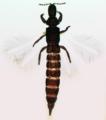Haplothrips halophilus
Recognition data
Distinguishing features
Both sexes fully winged. Body brown to dark brown; fore tarsi and inner apex of fore tibiae, also pedicel of antennal segment III yellowish; fore wing pale with extreme base shaded. Head longer than wide; maxillary stylets one third of head width apart, retracted to postocular setae, maxillary bridge complete; postocular setae bluntly pointed, about half as long as eyes. Antennae 8-segmented, segment III short with one sensorium, IV with 4 sensoria; segment VIII short and broad at base. Pronotum with three pairs of weakly capitate major setae, anteromarginal and midlateral setae no longer than discal setae; epimeral sutures complete; prosternal basantra and ferna large, mesopresternum eroded to paired lateral triangles. Fore tarsal tooth prominent and recurved at inner apex of tarsus. Fore wing with about 10 duplicated cilia, sub-basal setae S1 and S2 blunt to weakly capitate, S3 acute. Tergite IX setae S1 bluntly pointed, shorter than tube, S2 acute.
Male with broadly based fore tarsal tooth; pronotal midlateral setae well-developed; sternite VIII without pore plate; tergite IX setae S2 short and stout; pseudovirga of aedeagus slender.
Related and similar species
In California, the only species similar to H. halophilus is H. ruber (Moulton), but that is known only from a single female that has capitate rather than pointed postocular setae (Cott, 1957). The genus Haplothrips, one of the three most species rich genera of Thysanoptera, currently includes about 245 species worldwide (Mound & Minaei, 2007), these being found mainly from Europe across the Old World. No member of the genus is known to be endemic to the Neotropics, although a few species come from southern South America (Mound & Zapater, 2003), and only 17 species are listed from Mexico and North America (Mound & Marullo, 1996) with six of these recorded from California (Hoddle et al. 2004). Little is known of the biology of the Californian species, although elsewhere the species of Haplothrips are associated particularly with the flowers of Poaceae and Asteraceae.
Taxonomic data
Current valid name
Haplothrips halophilus Hood
Original name and synonyms
- Haplothrips halophilus Hood, 1915: 29
Family placement
Phlaeothripidae, Phlaeothripinae
Biological data
Life history
Presumably breeding in flowers
Host plants
Possibly Poaceae, most available specimens having been swept from grasses.
Tospoviruses vectored
None
Crop damage
None
Distribution data
Area of origin
Western USA
Distribution
Utah, Arizona, New Mexico, Texas, California.










